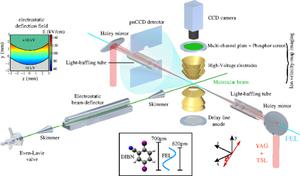Gas-phase diffraction published in Phys. Rev. Lett.
28 February, 2014
Schematic view of the experimental setup: from the left, a supersonic beam with quantum-state selected molecules is delivered to the interaction point. In the center of a dual velocity map imaging spectrometer, the molecular beam is crossed by laser beams copropagating from right to left. The direct laser beams go through a gap in the pnCCD detectors that are used to record the diffraction pattern. The upper pnCCD panel is further away from the beam axis than the bottom panel in order to cover a wider range of scattering angles. In the inset, the molecular structure of 2,5-diiodobenzonitrile is depicted, together with a scale of its size, i.e., the iodine-iodine distance, and the wavelength of the x rays.
Our paper about the first experimental demonstration of x-ray diffraction from ensembles of quantum-state selected and laser-aligned gas-phase molecules, performed at the X-ray Free-Electron Laser LCLS is published: "X-Ray Diffraction from Isolated and Strongly Aligned Gas-Phase Molecules with a Free-Electron Laser", Phys. Rev. Lett. 112, 083002 (2014). This experiment is a first step toward coherent diffractive imaging of structures and structural dynamics of isolated molecules at atomic (picometers and femtoseconds) resolution in future experiments at X-ray free-electron lasers.
The work is covered by press releases A Molecular Ballet under the X-ray Laser and Molekülballett im Röntgenlaser and an APS Focus story.
